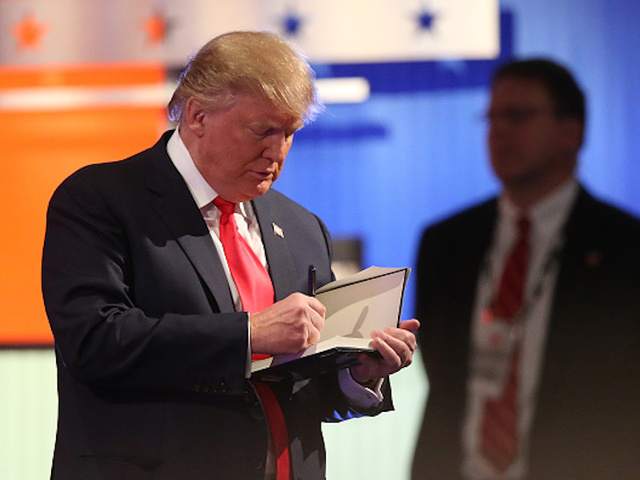By Erin Thiele and Barry Neil Shrum, Esq.
In the mid-1980s, Donald Trump approached Tony Schwartz to ghost write his autobiography. At this point in time, Trump was in his early 30s and did not have a great deal of life experiences about which to write a personal biography. So, according to Schwartz, he suggested instead that writing a book discussing Trump’s deal-making acumen was a bett er idea, and offered up the title, “The Art of the Deal.” So that’s what they agreed to do. The collaboration ended up on the New York Times best-seller list in 1987 and remained there for almost a year.
er idea, and offered up the title, “The Art of the Deal.” So that’s what they agreed to do. The collaboration ended up on the New York Times best-seller list in 1987 and remained there for almost a year.
That Trump and Schwartz collaborated on the book is no secret, since Schwartz received prominent credit on the front cover. Legally, that takes this project out of the realm of pure “ghostwriting” and places it firmly in the area of joint authorship as defined at 17 U.S.C. 201.
I often explain to my “co-write obsessed” songwriter clients in Nashville that when you enter into a collaboration of this nature with another author, it’s a lot like being in a long-term relationship in that 50% of them end in divorce! That’s why it always good to have some form of written understanding in place whether you are co-writing or ghost writing.
Fast-forward to present day America where there is a decidedly unpopular duo of presidential candidates which includes Trump’s name on the Republican ticket, amidst a constant whirlwind of controversy and media circuses. Trump has many times referenced The Art of the Deal on the campaign trail and ranks it among one of his greatest accomplishments.
Schwartz, for his part, obviously feels distraught and remorseful for putting the “T” in Trump. So, he jumped into the fray suddenly, appearing on Good Morning America with nothing but unfavorable things to say about Art of the Deal and, perhaps more to the point, about his co-writer, Donald Trump.
Schwartz claims he “wrote every word” of the manuscript, further alleging that Art of the Deal is filled with fictional accounts of the deals created in his own mind. Trump’s lawyers strongly deny these charges, insisting in their cease and desist letter to Schwartz that the deals are real, and that it was Trump, not Schwartz, that actually made the deals described in the book and that Trump is solely responsible for its success. The cease and desist requests, among other things, a return of all the royalties Schwartz has made on the book.
This reaction was no shock to Schwartz who, in reply, says:
“I . . . almost immediately received this cease and desist letter delivered to me by FedEx and it’s nuts, . . . completely indicative of who he is. . . . I fully expected him to attack me because that is what he does, so I can’t say I’m surprised. But I’m much worried about his becoming president than I am about anything he might try to do to me.”
From what can be gleaned from news stories related to the controversy, the original agreement between Schwartz and Trump provided that each author would receive half of the book’s $500,000 advance from Random House, as well as half of the royalties from Trump’s agreement with the publisher. This substantiates what the Trump camp has been saying, i.e., that Schwartz has made a great deal of money off the best-selling work: so much so, in fact, that Schwartz and Trump inked a deal for the audio version less than 3 years ago.
 So, the question becomes was there anything that Trump could have done to prevent these kinds of actions by Schwartz. More broadly, is there anything one joint author can do to prevent the other joint author from denigrating their work? The answer, you might suspect, lies in the language of the written agreement between the authors.
So, the question becomes was there anything that Trump could have done to prevent these kinds of actions by Schwartz. More broadly, is there anything one joint author can do to prevent the other joint author from denigrating their work? The answer, you might suspect, lies in the language of the written agreement between the authors.
Let’s start there. Anytime you collaborate with another author, you should insist on a written collaboration agreement. Anytime you want to hire a ghost writer to draft your memoirs, insist on a ghost writing agreement. There, I got that out of my system.
But this is apparently a trickier question when it comes to the Schwartz/Trump agreement, since this agreement between the two of them appears more like a collaboration agreement than a ghost writing agreement. A glance at the copyright database indicates that Donald Trump is the owner of the copyright, while Schwartz is listed as an author alongside, or “with” Donald Trump. So, perhaps the agreement is some sort of hybrid between to two.
When it comes to ghost writing arrangements, there are several grey areas that one should address in the written agreement with the person writing it. But first and foremost, the issue of who owns the work should be specified. Usually, in the ghost writing situation, the person hiring the writer is considered the “employer for hire” and the work is then considered a “work made for hire.”
In contrast, in a joint authorship or collaboration agreement, the authors usually own the work together, each holding an “undivided” interest in the copyright (meaning they can exploit 100% of it) and share an equal percentage of the royalties as well as an obligation to account to the other for receipt of any royalties.
Needless to say, in either situation, if one party wishes to be the sole owner of the copyright, there must be a written contract that is specifically states that the author does not own an interest in that copyright, has assigned that copyright, or has performed the work as an employee for hire. The justification for allowing this kind of transaction are too varied to go into here, but primarily if the originator of the idea funds the completion of the work, that person, NOT the ghostwriter, should own the copyright.
Another preventative negotiating point in either situation would be a provision in the contract that neither author will do anything either during the term of the agreement or afterward that would be “harmful” to the work. For example, the person hiring the ghostwriter might insist on a “non-disparagement” provision providing that neither party will intentionally be involved in any conduct or activity that may reasonably be anticipated to harm the other party or the work itself. This type of clause may also have provisions that include liquidated damages and even allow for injunctive relief. Any of these could have been available to Trump in this situation.
In addition, especially in ghostwriting situations, the non-disparagement clause combines with confidentiality and non-disclosure clauses which prevent an author from disclosing information about his/her work on the book. This contract provision has been effective for years, as many great works of authorship have been written in the shadows whilst their authors remain quiet. John Kennedy’s famous work, Profiles in Courage, for example, was ostensibly written by his chief speechwriter Ted Sorensen, according to the latter’s autobiography released many years after Kennedy’s death when he was no longer subject to the provision. The key purpose of these types of clauses is that the authors can control what the other author, particularly a ghost writer, can, and more importantly, cannot say about the work.
Needless to say, Trump could have prevented much of the negative publicity that Schwartz is generated if he had more cautiously drafted agreement that addressed these issues and kept The Art of the Deal and Trump’s reputation protected from allegations, true or not.
Regardless if you are co-writing or ghostwriting, you should explain your situation to a well-informed entertainment attorney and obtain a well-drafted contract to protect your specific situation, as well as your intellectual property.
A special thanks to my intern Erin Thiele for her helpful contributions to this piece. Erin attends Belmont University’s Mike Curb School of Music and Entertainment Business.
















